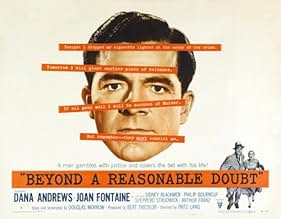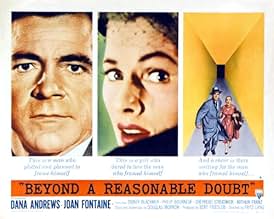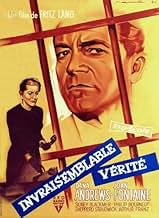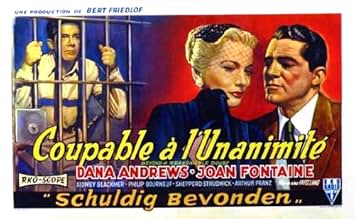IMDb रेटिंग
6.9/10
6.3 हज़ार
आपकी रेटिंग
अपनी भाषा में प्लॉट जोड़ेंA novelist aided by his future father-in-law conspires to frame himself for the murder of a burlesque dancer as part of an effort to ban capital punishment.A novelist aided by his future father-in-law conspires to frame himself for the murder of a burlesque dancer as part of an effort to ban capital punishment.A novelist aided by his future father-in-law conspires to frame himself for the murder of a burlesque dancer as part of an effort to ban capital punishment.
- पुरस्कार
- कुल 1 नामांकन
William F. Leicester
- Charlie Miller
- (as William Lester)
फ़ीचर्ड समीक्षाएं
Sometimes, in the world of 1940s-1950s film noir, we are given a film so transparently impossible and contrived that we can see ourselves giving up on watching it half way through. But is extremely rare that we are faced with a film where the very response the viewer is having holds the key to the success, rather than the failure, of the film.
Such is the case with BEYOND A REASONABLE DOUBT, which has - to its credit - been completely misunderstood by many. When we reach the film's conclusion, we realize that even the title of the film itself is a joke, perhaps the ultimate prank on the viewer. Yet to offer analysis of the film would be to destroy its main and most sinister motive; you can't "explain away" the glaring plot holes and contrivances without revealing the twist the film takes in its climax, and to do would rob the viewer of a genuine experience. So... I won't.
Suffice it to say, BEYOND A REASONABLE DOUBT is far more than it seems and is nothing without the sum of its parts, in total. Lang tackles the story of a person who creates a fictitious role for himself in order to, essentially, pull a fast one on the legal profession for personal gain (or, as it appears on the surface, someone else's). In the world of film noir, of course, we know that such a character won't get away with it, but when Lang depicts the tragedy the viewer knows will come, he majestically turns the entire premise on its head. As a result, it's a cold slap in the face - a devastating critique of the complicity of the audience in following along, hungrily, with such contrivances in cinema.
Every part of the film fits perfectly by not fitting at all. Even the visual style of the film is a cold, rarely pleasing one, almost daring you to suspend your disbelief just a little bit longer without even granting the pleasure of emotionally charged close-ups at key moments. The editing is brutal and jarring, cutting away practically mid-sentence and moving to a similar conversation elsewhere.
As a swan song to his Hollywood career, BEYOND A REASONABLE DOUBT does to the audience what Billy Wilder does to the industry in SUNSET BLVD. - biting the hand that feeds. The result is a total masterpiece.
Such is the case with BEYOND A REASONABLE DOUBT, which has - to its credit - been completely misunderstood by many. When we reach the film's conclusion, we realize that even the title of the film itself is a joke, perhaps the ultimate prank on the viewer. Yet to offer analysis of the film would be to destroy its main and most sinister motive; you can't "explain away" the glaring plot holes and contrivances without revealing the twist the film takes in its climax, and to do would rob the viewer of a genuine experience. So... I won't.
Suffice it to say, BEYOND A REASONABLE DOUBT is far more than it seems and is nothing without the sum of its parts, in total. Lang tackles the story of a person who creates a fictitious role for himself in order to, essentially, pull a fast one on the legal profession for personal gain (or, as it appears on the surface, someone else's). In the world of film noir, of course, we know that such a character won't get away with it, but when Lang depicts the tragedy the viewer knows will come, he majestically turns the entire premise on its head. As a result, it's a cold slap in the face - a devastating critique of the complicity of the audience in following along, hungrily, with such contrivances in cinema.
Every part of the film fits perfectly by not fitting at all. Even the visual style of the film is a cold, rarely pleasing one, almost daring you to suspend your disbelief just a little bit longer without even granting the pleasure of emotionally charged close-ups at key moments. The editing is brutal and jarring, cutting away practically mid-sentence and moving to a similar conversation elsewhere.
As a swan song to his Hollywood career, BEYOND A REASONABLE DOUBT does to the audience what Billy Wilder does to the industry in SUNSET BLVD. - biting the hand that feeds. The result is a total masterpiece.
Tom Garrett is a writer engaged to the daughter of wealthy newspaper man Austin Spencer. Spencer is also firmly against the death penalty. With Tom looking for a subject for a second novel, Spencer suggests that they set Tom up for an unsolved murder using circumstantial evidence to prove how easy it would be for the courts to kill an innocent man. Once Tom is sentenced to the chair, Spencer will expose the failings in the system and free him. However when Spencer is killed in car crash and none of the evidence can be found then Tom faces the chair.
A very interesting concept still needs a good delivery to make for a good film. This not only had a good idea but it was also a fair point to be made about the death penalty. The film moves along with a good build up for the whole first half. However once Tom finds himself in real trouble then the film strangely doesn't manage to deliver as much tension as it really should have done. Conversely the film becomes more of a melodrama for a while and it loses a lot of momentum. There are some nice touches at the end but they can't completely make up for the weaknesses in the middle section.
It is quite atmospheric but not to the point that I had hoped but Lang does a good job on direction. The cast are OK. Andrews has long been one of my favourite actors from the period and he gives a solid if unspectacular show here. Fontaine is weaker and doesn't quite convince as well as Andrews but is fine. Blackmer is pretty enjoyable as Austin Spencer and Ed Binns is a familiar face as Lt. Kennedy.
It doesn't quite work as you'd hope as the tension drops off at the exactly the moment that it needs to step up a notch. It is worth watching but it is not one of Lang's better films.
A very interesting concept still needs a good delivery to make for a good film. This not only had a good idea but it was also a fair point to be made about the death penalty. The film moves along with a good build up for the whole first half. However once Tom finds himself in real trouble then the film strangely doesn't manage to deliver as much tension as it really should have done. Conversely the film becomes more of a melodrama for a while and it loses a lot of momentum. There are some nice touches at the end but they can't completely make up for the weaknesses in the middle section.
It is quite atmospheric but not to the point that I had hoped but Lang does a good job on direction. The cast are OK. Andrews has long been one of my favourite actors from the period and he gives a solid if unspectacular show here. Fontaine is weaker and doesn't quite convince as well as Andrews but is fine. Blackmer is pretty enjoyable as Austin Spencer and Ed Binns is a familiar face as Lt. Kennedy.
It doesn't quite work as you'd hope as the tension drops off at the exactly the moment that it needs to step up a notch. It is worth watching but it is not one of Lang's better films.
This film features Dana Andrews as Tom Garrett, a novelist who is facing a deadline by his publisher to complete his next book. His future father-in-law, Austin Spencer, works has an editor for the big newspaper in town. Spencer has enough clout as an editor that he's regularly in touch with the District Attorney and local law enforcement. Spencer is also anti-capital punishment and is often at odds with the DA, who is very much pro-capital punishment. Spencer feels that the DA feels no qualms about sentencing people to death, because he wants to be seen as the man who makes someone pay for whatever crime he's prosecuting--regardless of whether he presents hard evidence or circumstantial.
An execution is presented at the beginning of the film. Through conversations between Garrett and Spencer and later, Garrett, Spencer and the DA, we learn that the DA has been thought of as taking the most inconsequential circumstantial evidence and manipulating it in court to make it seem like hard fact. Spencer feels like the DA often is grasping at straws, but because he wants to be seen as bringing justice to crimes, he is willing to manipulate any jury into a conviction. Spencer questions the DA about letting a potentially innocent man take the fall based on circumstantial evidence and not actual fact. The DA seems nonchalant about the whole thing.
For his book, Spencer suggests to Garrett that he write a book about someone who is convicted of a crime based on circumstantial evidence. 1) It will give Garrett something to write about, and 2) Spencer will hopefully be able to prove his point to the DA that innocent men could be convicted and executed based on circumstantial evidence. The plan is that Garrett and Spencer will find a crime where the police have no leads. They will then plant evidence in order to focus the police attention on Garrett as the possible perpetrator and implicate him in a crime. They're hoping that Garrett will be arrested and brought to trial. Along the way, Spencer and Garrett plan on taking photos of Garrett planting the evidence so that the photos can be presented to the court in the event that Garrett is convicted of the crime.
You just know from the get-go that something is going to go wrong. Otherwise, where's the suspense? What I did not expect was the ending of the film. What a great twist.
Joan Fontaine is rather wasted in her thankless role as Susan Spencer, Andrews' fiancee and daughter of Austin Spencer. Her finest moment in the film is towards the end, but even then, I think many other actresses could have handled the part--it wouldn't have required an Oscar winner.
An execution is presented at the beginning of the film. Through conversations between Garrett and Spencer and later, Garrett, Spencer and the DA, we learn that the DA has been thought of as taking the most inconsequential circumstantial evidence and manipulating it in court to make it seem like hard fact. Spencer feels like the DA often is grasping at straws, but because he wants to be seen as bringing justice to crimes, he is willing to manipulate any jury into a conviction. Spencer questions the DA about letting a potentially innocent man take the fall based on circumstantial evidence and not actual fact. The DA seems nonchalant about the whole thing.
For his book, Spencer suggests to Garrett that he write a book about someone who is convicted of a crime based on circumstantial evidence. 1) It will give Garrett something to write about, and 2) Spencer will hopefully be able to prove his point to the DA that innocent men could be convicted and executed based on circumstantial evidence. The plan is that Garrett and Spencer will find a crime where the police have no leads. They will then plant evidence in order to focus the police attention on Garrett as the possible perpetrator and implicate him in a crime. They're hoping that Garrett will be arrested and brought to trial. Along the way, Spencer and Garrett plan on taking photos of Garrett planting the evidence so that the photos can be presented to the court in the event that Garrett is convicted of the crime.
You just know from the get-go that something is going to go wrong. Otherwise, where's the suspense? What I did not expect was the ending of the film. What a great twist.
Joan Fontaine is rather wasted in her thankless role as Susan Spencer, Andrews' fiancee and daughter of Austin Spencer. Her finest moment in the film is towards the end, but even then, I think many other actresses could have handled the part--it wouldn't have required an Oscar winner.
Fritz Lang's twenty years as a Hollywood refugee, which had started so spiritedly with "Fury", gradually wound down to the grey, listless offering that is "Beyond a Reasonable Doubt". True, Lang's first and last titles have family resemblances. "Fury" concerns a man who may or may not have committed a capital crime but who deserves due process rather than lynching; "Doubt" is about a guy who frames himself to prove that the irrevocable sentence of capital punishment, legal or not, is never justifiable if the law is fallible.
But whereas the argument of "Fury" was driven full steam ahead by a master of montage ("Metropolis") and suspenseful pacing ("M"), "Doubt" consists largely of two- or three-shots of men in suits with "display kerchiefs", arguing in paneled offices with unraised voices. The story has its due ration of twists as Dana Andrews's writer is persuaded by his prospective father-in-law, a crusading press magnate, to set himself up as a burlesque dancer's killer; the two of them will keep records of the plot that are sure to exonerate Andrews before he faces the chair. (Wouldn't he get a stiff sentence for wasting the cops' time, though?)
But the focus shifts awkwardly from Andrews to his girl and lawyer as it unwinds, and the scenario is oddly bare of dramatic crises. For example, the press boss's death occurs off screen and his exoneration is brought in by his lawyer, not tracked down by his daughter, Andrews's fiancée. Only a few backstage scenes with the dancing girls, all peroxide and nasal cynicism, enliven proceedings. Andrews had begun to freeze into the stone faced stolidity which hampered his later career, while 39 year old Fontaine (the classic aging actress's age) is matronly in costume, maquillage and demeanor: encased in stately prissiness like other English ladies of Hollywood such as Garson and Kerr.
Apart from Fontaine the production looks as well as feels impoverished, aesthetically like Ida Lupino's and Collier Young's problem pics but without their punch. The final twist is not signaled strongly enough to give smarter audience members a decent chance of foreseeing it. At one ludicrous moment, the publisher suggests his guests catch up on the day's highlights in Andrews's murder trial: he turns on a TV which immediately and obligingly recounts them, like George Burns's magic set on "The Burns and Allen Show". Incidentally, was covering trials and commenting on them normal for American television c. 1955?
"Beyond a Reasonable Doubt" was a swansong not only for Lang but for RKO. It had abandoned production three years earlier after being wrecked by Howard Hughes, had sold its studio to Desi and Lucy and was now reduced to releasing outside product: in this instance from one Bert Friedlob. It really was time for Herr Lang to catch the plane back to de-Nazified Germany.
But whereas the argument of "Fury" was driven full steam ahead by a master of montage ("Metropolis") and suspenseful pacing ("M"), "Doubt" consists largely of two- or three-shots of men in suits with "display kerchiefs", arguing in paneled offices with unraised voices. The story has its due ration of twists as Dana Andrews's writer is persuaded by his prospective father-in-law, a crusading press magnate, to set himself up as a burlesque dancer's killer; the two of them will keep records of the plot that are sure to exonerate Andrews before he faces the chair. (Wouldn't he get a stiff sentence for wasting the cops' time, though?)
But the focus shifts awkwardly from Andrews to his girl and lawyer as it unwinds, and the scenario is oddly bare of dramatic crises. For example, the press boss's death occurs off screen and his exoneration is brought in by his lawyer, not tracked down by his daughter, Andrews's fiancée. Only a few backstage scenes with the dancing girls, all peroxide and nasal cynicism, enliven proceedings. Andrews had begun to freeze into the stone faced stolidity which hampered his later career, while 39 year old Fontaine (the classic aging actress's age) is matronly in costume, maquillage and demeanor: encased in stately prissiness like other English ladies of Hollywood such as Garson and Kerr.
Apart from Fontaine the production looks as well as feels impoverished, aesthetically like Ida Lupino's and Collier Young's problem pics but without their punch. The final twist is not signaled strongly enough to give smarter audience members a decent chance of foreseeing it. At one ludicrous moment, the publisher suggests his guests catch up on the day's highlights in Andrews's murder trial: he turns on a TV which immediately and obligingly recounts them, like George Burns's magic set on "The Burns and Allen Show". Incidentally, was covering trials and commenting on them normal for American television c. 1955?
"Beyond a Reasonable Doubt" was a swansong not only for Lang but for RKO. It had abandoned production three years earlier after being wrecked by Howard Hughes, had sold its studio to Desi and Lucy and was now reduced to releasing outside product: in this instance from one Bert Friedlob. It really was time for Herr Lang to catch the plane back to de-Nazified Germany.
Beyond a Reasonable Doubt (1956)
An early wide screen black and white drama that marks the end of Fritz Lang's American career and also shows the winding down of two great stars, Joan Fontaine and Dana Andrews. The film is no send off, exactly, but it is slightly tired, as if the formula of movie-making needs a twist and it isn't here.
That's not the point, of course. This is now the mid-fifties, crisis time for Hollywood, and with widescreen (and widescreen color) movies making a final jab at the rise of television. The plot is sensational, and not too far from what an extended early television drama might try, with mostly interior shooting and a staged (sometimes stagey) presentation. In all it's not Lang's best, and he was a master at both noir/expressionist drama and at getting to the human dilemma of fate and murder.
Andrews and Fontaine are not a bad pair—both are matched in calm and sophistication, and beauty, even, though Fontaine seems like an accessory until the very end. Andrews rules the plot, which makes him out to be a writer desperate for a new story. So desperate he's going to pretend to commit a murder just to test the justice system.
It's all so outrageous you want to believe it, though your mind says it just wouldn't happen. It's too convenient, and one man's suggestion from the newspaper turns out to be the other man's reality. Enough said!
Oddly enough, this is an RKO distribution even after the studio's demise (I don't know the reasons there) but it might point to a less than perfect crew. Certainly the cinematographer, which Lang relied on greatly in earlier films, is no one with credentials. Likewise the editing and writing are fairly routine, even lackluster. And so if a movie that depends on some psychological intensity is really a bit of a grunt effort, whatever the star power involved, it's a bit doomed.
So watch this if you are curious about any of the parts. I'm a fan of all three of the principles here, and so had to watch it. But I didn't walk away impressed.
An early wide screen black and white drama that marks the end of Fritz Lang's American career and also shows the winding down of two great stars, Joan Fontaine and Dana Andrews. The film is no send off, exactly, but it is slightly tired, as if the formula of movie-making needs a twist and it isn't here.
That's not the point, of course. This is now the mid-fifties, crisis time for Hollywood, and with widescreen (and widescreen color) movies making a final jab at the rise of television. The plot is sensational, and not too far from what an extended early television drama might try, with mostly interior shooting and a staged (sometimes stagey) presentation. In all it's not Lang's best, and he was a master at both noir/expressionist drama and at getting to the human dilemma of fate and murder.
Andrews and Fontaine are not a bad pair—both are matched in calm and sophistication, and beauty, even, though Fontaine seems like an accessory until the very end. Andrews rules the plot, which makes him out to be a writer desperate for a new story. So desperate he's going to pretend to commit a murder just to test the justice system.
It's all so outrageous you want to believe it, though your mind says it just wouldn't happen. It's too convenient, and one man's suggestion from the newspaper turns out to be the other man's reality. Enough said!
Oddly enough, this is an RKO distribution even after the studio's demise (I don't know the reasons there) but it might point to a less than perfect crew. Certainly the cinematographer, which Lang relied on greatly in earlier films, is no one with credentials. Likewise the editing and writing are fairly routine, even lackluster. And so if a movie that depends on some psychological intensity is really a bit of a grunt effort, whatever the star power involved, it's a bit doomed.
So watch this if you are curious about any of the parts. I'm a fan of all three of the principles here, and so had to watch it. But I didn't walk away impressed.
क्या आपको पता है
- ट्रिवियाFinal American film made by Fritz Lang before returning to Germany. It was a box-office failure.
- गूफ़WHile the trial is shown on TV there is a frontal shot of Tom sitting at the defendants desk. This would not be possible as the television camera was stationed behind and to the side of the desk. It's not feasible that the large 1950's era television camera would have been moved to the front of the courtroom for the shot.
- भाव
Tom Garrett: Well, could I get in touch with you?
Dolly Moore: You've touched enough already!
- कनेक्शनFeatured in Private Property (1960)
- साउंडट्रैकBeyond A Reasonable Doubt
Sung by The Hi-Los (as The Hi-Lo's)
Music by Herschel Burke Gilbert
Lyrics by Alfred Perry
टॉप पसंद
रेटिंग देने के लिए साइन-इन करें और वैयक्तिकृत सुझावों के लिए वॉचलिस्ट करें
- How long is Beyond a Reasonable Doubt?Alexa द्वारा संचालित
विवरण
- रिलीज़ की तारीख़
- कंट्री ऑफ़ ओरिजिन
- भाषा
- इस रूप में भी जाना जाता है
- Más allá de la duda
- फ़िल्माने की जगहें
- शिकागो, इलिनॉय, संयुक्त राज्य अमेरिका(location shooting)
- उत्पादन कंपनी
- IMDbPro पर और कंपनी क्रेडिट देखें
- चलने की अवधि1 घंटा 20 मिनट
- रंग
इस पेज में योगदान दें
किसी बदलाव का सुझाव दें या अनुपलब्ध कॉन्टेंट जोड़ें

टॉप गैप
By what name was Beyond a Reasonable Doubt (1956) officially released in India in English?
जवाब




































